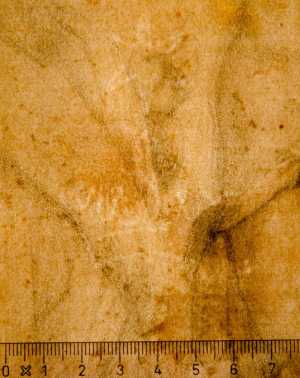Specifications
| Title | Christ Between Saints Cosmas and Damian |
|---|---|
| Material and technique | Black chalk |
| Object type |
Drawing
> Two-dimensional object
> Art object
|
| Location | This object is travelling |
| Dimensions |
Height 409 mm Width 308 mm |
|---|---|
| Artists |
Draughtsman:
Alessandro Allori
Previously attributed: Pontormo (Jacopo Carucci) |
| Accession number | DN 117/14 (PK) |
| Credits | Gift Dr A.J. Domela Nieuwenhuis, 1923 |
| Department | Drawings & Prints |
| Acquisition date | 1923 |
| Creation date | in circa 1560 |
| Watermark | Crown with six-pointed star above (67 x 47 mm, centre left, on P3 of 8P, vH, cropped folio), no similar type with a star in Briquet, similar to Piccard Online DE8085-PO-51648 (48 x 32 mm; Parchwitz, Oder, 1565) but larger [see image] |
| Inscriptions | ‘Di Angiol Bronzino’ (verso, lower left, pen and brown ink), ‘di Bronzino’ (verso, centre, red chalk), ‘in Paolo’ (verso, centre left, pen and brown ink, crossed out) |
| Collector | Collector / Adriaan Domela Nieuwenhuis |
| Mark | A.J. Domela Nieuwenhuis (L.356b) on removed fragment of old backing paper |
| Provenance | Dr. Adriaan J. Domela Nieuwenhuis (1850-1935, L.356b), Munich/Rotterdam, donated with his collection in 1923 (attributed to Pontormo) |
| Research |
Show research Italian Drawings 1400-1600 |
| Literature | Lecchini Giovannoni 1991, p. 218 |
| Material | |
| Object | |
| Geographical origin | Italy > Southern Europe > Europe |
Do you have corrections or additional information about this work? Please, send us a message

























